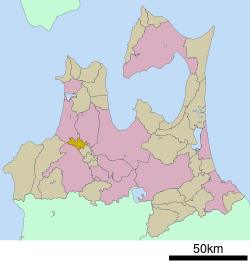Tsuruta, Aomori
| Tsuruta 鶴田町 | |||
|---|---|---|---|
| Town | |||
|
Tsuruta Station | |||
| |||
 Location of Tsuruta in Aomori Prefecture | |||
 Tsuruta
| |||
| Coordinates: 40°45′N 140°26′E / 40.750°N 140.433°ECoordinates: 40°45′N 140°26′E / 40.750°N 140.433°E | |||
| Country | Japan | ||
| Region | Tōhoku | ||
| Prefecture | Aomori Prefecture | ||
| District | Kitatsugaru | ||
| Area | |||
| • Total | 46.41 km2 (17.92 sq mi) | ||
| Population (September 2013) | |||
| • Total | 13,766 | ||
| • Density | 297/km2 (770/sq mi) | ||
| Time zone | Japan Standard Time (UTC+9) | ||
| - Tree | Japanese black pine | ||
| - Flower | Apple | ||
| - Bird | Red-crowned Crane | ||
| Phone number | 0173-22-2111 | ||
| Address |
200-1 Hayase, Tsuruta-machi, Kitatsugaru-gun, Aomori-ken 038-3503 | ||
| Website | Official website | ||
Tsuruta (鶴田町 Tsuruta-machi) is a town located in Kitatsugaru District of northeastern Aomori Prefecture in the Tōhoku region of Japan. As of September 2013, the town has an estimated population of 13,766 and a population density of 297 persons per km². Its total area is 46.4 km².The name "Tsuruta" is a combination of the character for crane (鶴) with that for rice field (田).
Geography
Tsuruta is located at the base of Tsugaru Peninsula. The town has a hot humid continental climate characterized by short warm to hot (and often humid) summers and cold winters with heavy snowfall. Tsuruta Town Office, approximately in the center of town, is 25 kilometers from the Sea of Japan and about 45 kilometers from Aomori City, the capital of Aomori Prefecture.
Neighbouring municipalities
History
The area around Tsuruta was controlled by the Nambu clan of Morioka Domain during the Edo period. After the Meiji Restoration, in 1895 it was formed into a village. It was elevated to town status on October 1, 1941. On March 1, 1955, it annexed the neighboring villages of Umezawa, Rokugo, and Mizumoto, and on November 1, 1958 it also annexed a portion of Itayanagi.
Economy
The economy of Tsuruta is heavily dependent on horticulture, especially for apples. Cold-hardy varieties of rice and many varieties of apples are grown in the town. Farmers in the area have developed a strain of apples that does not oxidize (turn brown) when cut.
Education
Tsuruta's school system is part of a new government pilot program in Japan. Schools participating in the program pick an area of focus and develop specialized curricula that expose young kids to the specialty at an early age. Tsuruta's school system focuses on teaching English to kids starting in preschool. To implement this program in elementary schools, Tsuruta employs CIRs, one from the JET Programme and one from Hood River, Oregon. In addition, ALTs are also employed at both the middle school and the high school. The Tsuruta-Hood River sister city relationship is among the most active in Japan, with groups of students and/or adults making a pilgrimage between the two towns several times a year.
Transportation
Railway
Highway
Events
Tsuruta is famous in Japan for having the longest wooden footbridge (300m) in Japan. It is said that anyone who walks across the bridge will have a long life. The bridge passes over Fujimi Lake in Fujimiko Park, where the town hosts a cherry blossom festival that falls sometime around Japan's Golden Week, May 3–5. The town is also host to a summer festival, Tsuruta Matsuri, when floats (nebuta ねぶた) parade through the central streets. This is a time when Tsuruta's townfolk take to the streets to make what is claimed to be Japan's longest sushi roll.
The town's central park, Fujimi Lake Park (富士見湖パーク), has views of the nearby volcano, Mount Iwaki, and has a stage where various events take place in the summer months. The lake, whose name means "Fuji view", is so called because Mount Iwaki has been called Mount Fuji of Tsugaru. The park also houses a number of red-crowned cranes.
Sister city
 Hood River, Oregon, United States of America since 1977
Hood River, Oregon, United States of America since 1977
External links
![]() Media related to Tsuruta, Aomori at Wikimedia Commons
Media related to Tsuruta, Aomori at Wikimedia Commons
- Tsuruta official website (English)
- Official website (Japanese)
- Local Area Guide (English)
| ||||||||||||||||||||||||||||||||||||||||